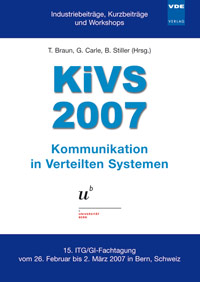On Fluctuation Resilience of Second Generation Distributed Hash Tables
Konferenz: KiVS 2007 - Kommunikation in Verteilten Systemen - 15. ITG/GI-Fachtagung
26.02.2007 - 02.03.2007 in Bern, Schweiz
Tagungsband: KiVS 2007
Seiten: 6Sprache: EnglischTyp: PDF
Persönliche VDE-Mitglieder erhalten auf diesen Artikel 10% Rabatt
Autoren:
Damm, Nis Ingvar; Fahrenholtz, Dietrich; Turau, Volker (Hamburg University of Technology, Institute of Telematics, Schwarzenbergstrasse 95, 21073 Hamburg, Germany)
Inhalt:
Every Peer-to-Peer system destined for real-world use has to face challenges imposed by peer dynamics, i.e., peers join and leave the system at their own discretion. So any Distributed Hash Table (DHT) design must take precautions against peer population fluctuation (aka. churn) to sustain efficient lookup performance. Although important, an analysis of the influence of varying fluctuation on the performance of 2nd generation DHTs in a unified attempt has not been done yet. An existing analysis by Li et al. aims at finding optimal parameters for those DHTs. However, optimal parameters were found out by simulating merely one fluctuation scenario. In this paper, we analyse second generation DHTs covering many topologies under different fluctuation rates and evaluate their performance in a simulation framework. Overall Kademlia attains the best lookup performance, but its bandwidth consumption goes up significantly when increasing fluctuation rate. With a limited bandwidth budget and high fluctuation rate, Kelips' lookup performance is the best among all examined DHTs.


